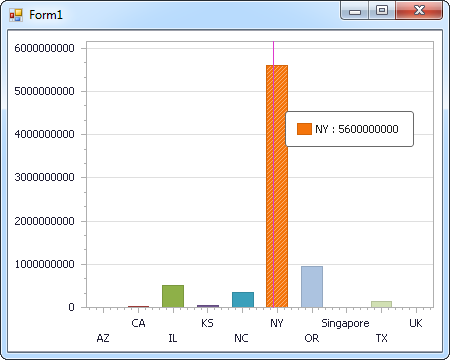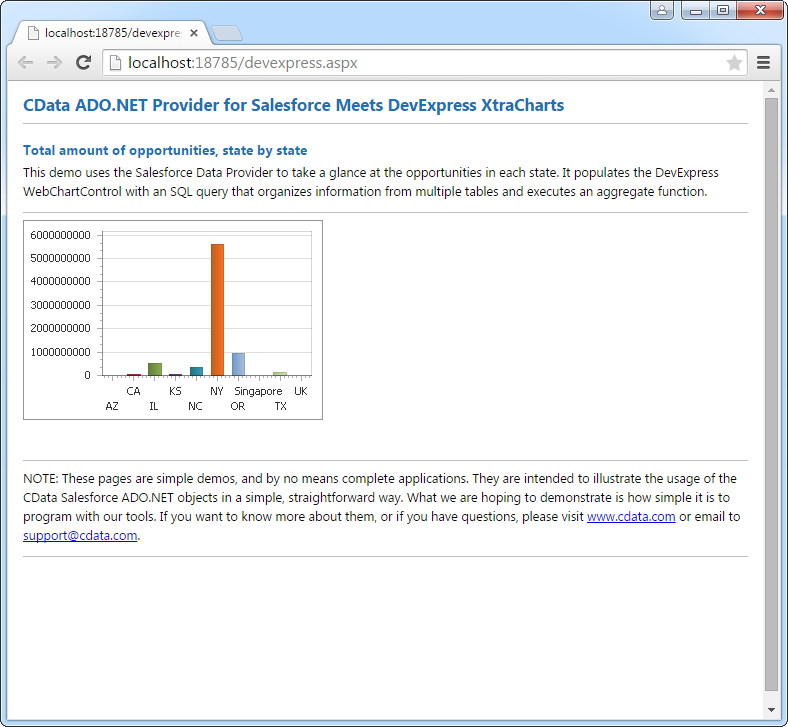Discover how a bimodal integration strategy can address the major data management challenges facing your organization today.
Get the Report →DataBind Salesforce Marketing Data to the DevExpress Data Grid
Use the CData ADO.NET Provider for Salesforce Marketing with the DevExpress Windows Forms and Web controls to provide Salesforce Marketing data to a chart.
The ADO.NET Provider for Salesforce Marketing by CData incorporates conventional ADO.NET data access components compatible with third-party controls. You can adhere to the standard ADO.NET data binding procedures to establish two-way access to real-time data through UI controls. This article will demonstrate the utilization of CData components for data binding with DevExpress UI Controls (Windows Forms and Web controls), specifically binding to a chart that visualizes live data.
Authenticating to the Salesforce Marketing Cloud APIs
Set the User and Password to your login credentials, or to the credentials for a sandbox user if you are connecting to a sandbox account.
Connecting to the Salesforce Marketing Cloud APIs
By default, the data provider connects to production environments. Set UseSandbox to true to use a Salesforce Marketing Cloud sandbox account.
The default Instance is s7 of the Web Services API; however, if you use a different instance, you can set Instance.
Windows Forms Controls
The code below shows how to populate a DevExpress chart with Salesforce Marketing data. The SFMarketingCloudDataAdapter binds to the Series property of the chart control. The Diagram property of the control defines the x- and y-axes as the column names.
using (SFMarketingCloudConnection connection = new SFMarketingCloudConnection(
"User=myUser;Password=myPassword;InitiateOAuth=GETANDREFRESH")) {
SFMarketingCloudDataAdapter dataAdapter = new SFMarketingCloudDataAdapter(
"SELECT Id, Status FROM Subscriber", connection);
DataTable table = new DataTable();
dataAdapter.Fill(table);
DevExpress.XtraCharts.Series series = new DevExpress.XtraCharts.Series();
chartControl1.Series.Add(series);
series.DataSource = table;
series.ValueDataMembers.AddRange(new string[] { "Status" });
series.ArgumentScaleType = DevExpress.XtraCharts.ScaleType.Qualitative;
series.ArgumentDataMember = "Id";
series.ValueScaleType = DevExpress.XtraCharts.ScaleType.Numerical;
chartControl1.Legend.Visibility = DevExpress.Utils.DefaultBoolean.False;
((DevExpress.XtraCharts.SideBySideBarSeriesView)series.View).ColorEach = true;
}

Web Controls
The code below shows how to populate a DevExpress Web control with Salesforce Marketing data. The SFMarketingCloudDataAdapter binds to the Series property of the chart; the Diagram property defines the x- and y-axes as the column names.
using DevExpress.XtraCharts;
using (SFMarketingCloudConnection connection = new SFMarketingCloudConnection(
"User=myUser;Password=myPassword;InitiateOAuth=GETANDREFRESH"))
{
SFMarketingCloudDataAdapter SFMarketingCloudDataAdapter1 = new SFMarketingCloudDataAdapter("SELECT Id, Status FROM Subscriber", connection);
DataTable table = new DataTable();
SFMarketingCloudDataAdapter1.Fill(table);
DevExpress.XtraCharts.Series series = new Series("Series1", ViewType.Bar);
WebChartControl1.Series.Add(series);
series.DataSource = table;
series.ValueDataMembers.AddRange(new string[] { "Status" });
series.ArgumentScaleType = ScaleType.Qualitative;
series.ArgumentDataMember = "Id";
series.ValueScaleType = ScaleType.Numerical;
((DevExpress.XtraCharts.SideBySideBarSeriesView)series.View).ColorEach = true;
}







